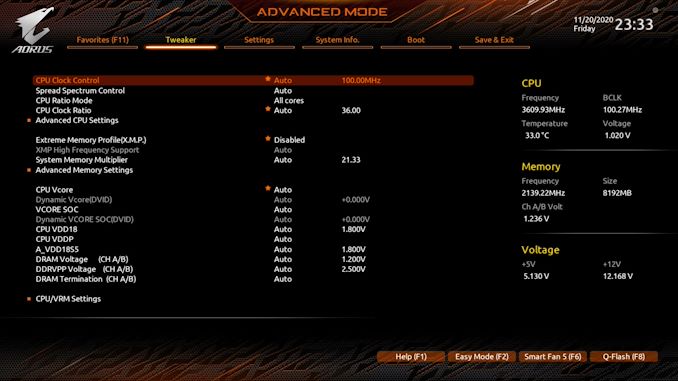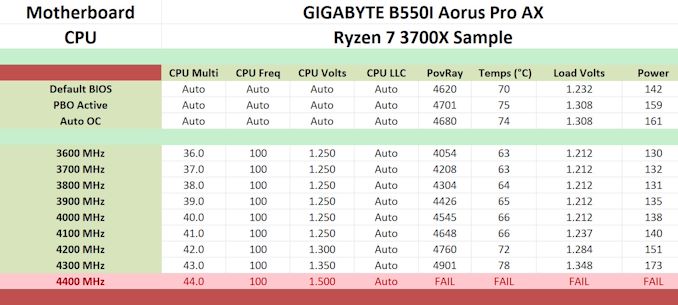The GIGABYTE B550I Aorus Pro AX Motherboard Review: All The Small Things
by Gavin Bonshor on December 7, 2020 10:00 AM ESTOverclocking Ryzen 3000
Experience with the GIGABYTE B550I Aorus Pro AX
When it comes to overclocking AMD's Ryzen 3000, pushing them to even modest all-core frequencies can mean they run very hot. Even with the most recent Zen 3 based Ryzen 5000 processors, Robert Hallock, who is AMD's Director of Technical Marketing, stated in response to a Redditor that they (Ryzen 5000) could quickly hit up to 95 degrees Celsius under full-load. According to Robert Hallock, this is a part of the design and should allow the Ryzen 5000 series chips to boost longer due to the higher temperature threshold, thus giving better performance all across the board. It is recommended that users looking to overclock Ryzen 3000, or even contemplate using the Ryzen 5000 series, do invest in adequate CPU cooling with premium AIO closed-loop coolers looking like the most strong candidates outside of the expensive custom liquid solutions on the market.
Focusing on our experience with the GIGABYTE B550I Aorus Pro AX, the firmware itself is user friendly and responsive as far as a BIOS goes. All of the relevant overclocking settings can be found within the Tweaker section, with options to overclock the CPU, iGPU, and memory all found here. Users can use the CPU ratio mode to make adjustments to the core clock speed, while fine tweaking can be done via the base clock under the CPU Clock Control option. For voltages, the CPU VCore is the most prominent option for pushing more juice to the CPU, while options to change the level of Load-Line Calibration of the 8-phase power delivery can be found under the CPU/VRM settings.
Memory overclocking can be done multiple ways, with X.M.P 2.0 profiles available by enabling the profile on compatible memory for ease of use. Other options for tuning the memory manually with the System Memory multiplier, altering the DRAM voltage, and a section dedicated to tweaking the memory timings. As we've previously noted in previous AM4 reviews, AMD recommends a maximum FCLK (Infinity Fabric Clock) to within 2:1 of the memory frequency, with the sweet spot sitting at DDR4-3600 with an FCLK of 1800 MHz.
Overclocking Methodology
Our standard overclocking methodology is as follows. We select the automatic overclock options and test for stability with POV-Ray and OCCT to simulate high-end workloads. These stability tests aim to catch any immediate causes for memory or CPU errors.
For manual overclocks, based on the information gathered from the previous testing, start off at a nominal voltage and CPU multiplier, and the multiplier is increased until the stability tests are failed. The CPU voltage is increased gradually until the stability tests are passed. The process is repeated until the motherboard reduces the multiplier automatically (due to safety protocol) or the CPU temperature reaches a stupidly high level (105ºC+). Our testbed is not in a case, which should push overclocks higher with fresher (cooler) air.
We overclock with the Ryzen 7 3700X for consistency with our previous overclocking tests.
Overclocking Results
Equipped with a solid 8-phase power delivery, the mini-ITX GIGABYTE performs pretty competitively in our overclocking tests. Not only is the B550I Aorus Pro AX more than capable of pushing a Ryzen 3000 beyond its limits comfortably, but it behaves very well in regards to VDroop in our manual testing. Our AM4 testing with the Ryzen 7 3700X stretches starts from 3.6 GHz and goes as far as we can in the headroom. Although our Ryzen 7 3700X, unfortunately, cannot do 4.4 GHz fully stable, 4.3 GHz is still a good overclock all-cores.
Our POV-Ray benchmark performance increased as we tested each frequency from 3.6 GHz to 4.3 GHz, with solid levels of VDroop control when comparing load CPU VCore to the values set within the BIOS. Naturally, as we increased the frequency, we saw higher temperatures a full load, but not as much when we upped the CPU VCore from 1.25 V to 1.30 and beyond. Power also crept up as we increased the frequency and CPU VCore, which is expected as more juice means more power from the wall.












76 Comments
View All Comments
mkarwin - Tuesday, December 15, 2020 - link
It might have inferior codec setup, but allows better flexibility and connectability using the rear panel I/O audio ports...Questor - Wednesday, December 9, 2020 - link
Unfortunately for Gigabyte, the lack of a front USB-C header is a deal breaker. I had the same thought you did, hoping and holding out for a V2.Gigaplex - Wednesday, December 9, 2020 - link
How much of a dealbreaker? You can get USB3 to USB-C header adapters.Questor - Thursday, December 10, 2020 - link
Hm. I didn't think about that. Amazing how we miss things right in front of us. Not so much of a deal breaker me thinks. As long as the USB connection is reachable, since it wasn't placed as a front panel header.OliveGray - Sunday, December 13, 2020 - link
These are 2 pay checks $78367 and $87367. that i received in last 2 months. I am very happy that i can make thousands in my part time and now i am enjoying my life. Everybody can do this and earn lots of dollars from home in very short time period. Just visit this website now. Your Success is one step away Copy and Paste___bit.ly/googlework43kkilobyte - Monday, December 7, 2020 - link
Hopefully, it isn't as buggy as their X570 motherboards, that drop dead randomly and require removing the CMOS battery to be able to start it again - an issue that Gigabyte, in more than a year, never solved or even tried to solve.meacupla - Monday, December 7, 2020 - link
That seems to be a common issue on any Gigabyte motherboard.It's like their EEPROM chips have a 50% failure rate within 3yrs and 90% in 5yrs
Deicidium369 - Monday, December 7, 2020 - link
I have dozens in service - some going back to Conroe and never once have had a EEPROM die - maybe you should look at your power delivery system.Samus - Monday, December 7, 2020 - link
I’ve seen EEPROM failure on a few gigabyte boards going back to socket 939 it’s widely known to be an issue and Gigabyte seemingly knows it because they were making the first (only behind ABIT and DFI) to advocate ‘DualBIOS’ which they naturally did away with awhile back because it is expensive.star-affinity - Tuesday, December 8, 2020 - link
:-OIs that why my (or my sister's nowadays) 11 year old Gigabyte GA-EX58-UD5 behaves like this:
https://www.dropbox.com/s/f0bgoxfquiu7mky/GA-EX58-...
I've done all I know of, switching around RAM modules, remove the CMOS battery, press reset CMOS on the back. Got it to start BIOS recovery from the ”DualBIOS” once, but even during that process it turned itself off.
Could be the power supply perhaps, but I've seen other videos online of Gigabyte motherboards doing the same.